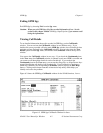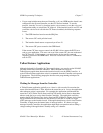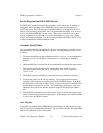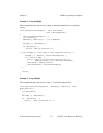GPIB Programming Techniques Chapter 7
NI-488.2 User Manual for Windows 7-2 © National Instruments Corp.
You can use the ibconfig function to configure the software to inform you whether or
not the GPIB EOI line was asserted when the EOS byte was read. Use the
IbcEndBitIsNormal option to configure the software to report only the END bit in
ibsta when the GPIB EOI line is asserted. By default, the NI-488.2 driver reports END
in ibsta when either the EOS byte is read in or the EOI line is asserted during a read.
High-Speed Data Transfers (HS488)
National Instruments has designed a high-speed data transfer protocol for IEEE 488
called HS488. This protocol increases performance for GPIB reads and writes up to
8 Mbytes/s, depending on your system.
HS488 is a superset of the IEEE 488 standard; thus, you can mix IEEE 488.1,
IEEE 488.2, and HS488 devices in the same system. If HS488 is enabled, the
TNT4882C hardware implements high-speed transfers automatically when
communicating with HS488 instruments. To determine whether your GPIB interface
board has the TNT4882C hardware, use the GPIBInfo utility. If you attempt to enable
HS488 on a GPIB board that does not have the TNT4882C chip, the error ECAP is
returned.
Enabling HS488
To enable HS488 for your GPIB board, use the ibconfig function (option
IbcHSCableLength). The value passed to ibconfig should specify the number of
meters of cable in your GPIB configuration. If you specify a cable length that is much
smaller than what you actually use, the transferred data could become corrupted. If you
specify a cable length longer than what you actually use, the data is transferred
successfully, but more slowly than if you specified the correct cable length.
In addition to using ibconfig to configure your GPIB board for HS488, the Controller-
In-Charge must send out GPIB command bytes (interface messages) to configure other
devices for HS488 transfers.
If you are using device-level calls, the NI-488.2 software automatically sends the HS488
configuration message to devices. If you enabled the HS488 protocol in wibconf, the
NI-488.2 software sends out the HS488 configuration message when you use ibdev to
bring a device online. If you call ibconfig to change the GPIB cable length, the
NI-488.2 software sends out the HS488 message again the next time you call a device-
level function.
If you are using board-level functions or NI-488.2 routines and you want to configure
devices for high-speed, you must send the HS488 configuration messages using ibcmd
or SendCmds. The HS488 configuration message is made up of two GPIB command
bytes. The first byte, the Configure Enable (CFE) message (hex 1F), places all HS488
devices into their configuration mode. Non-HS488 devices should ignore this message.
The second byte is a GPIB secondary command that indicates the number of meters of


















